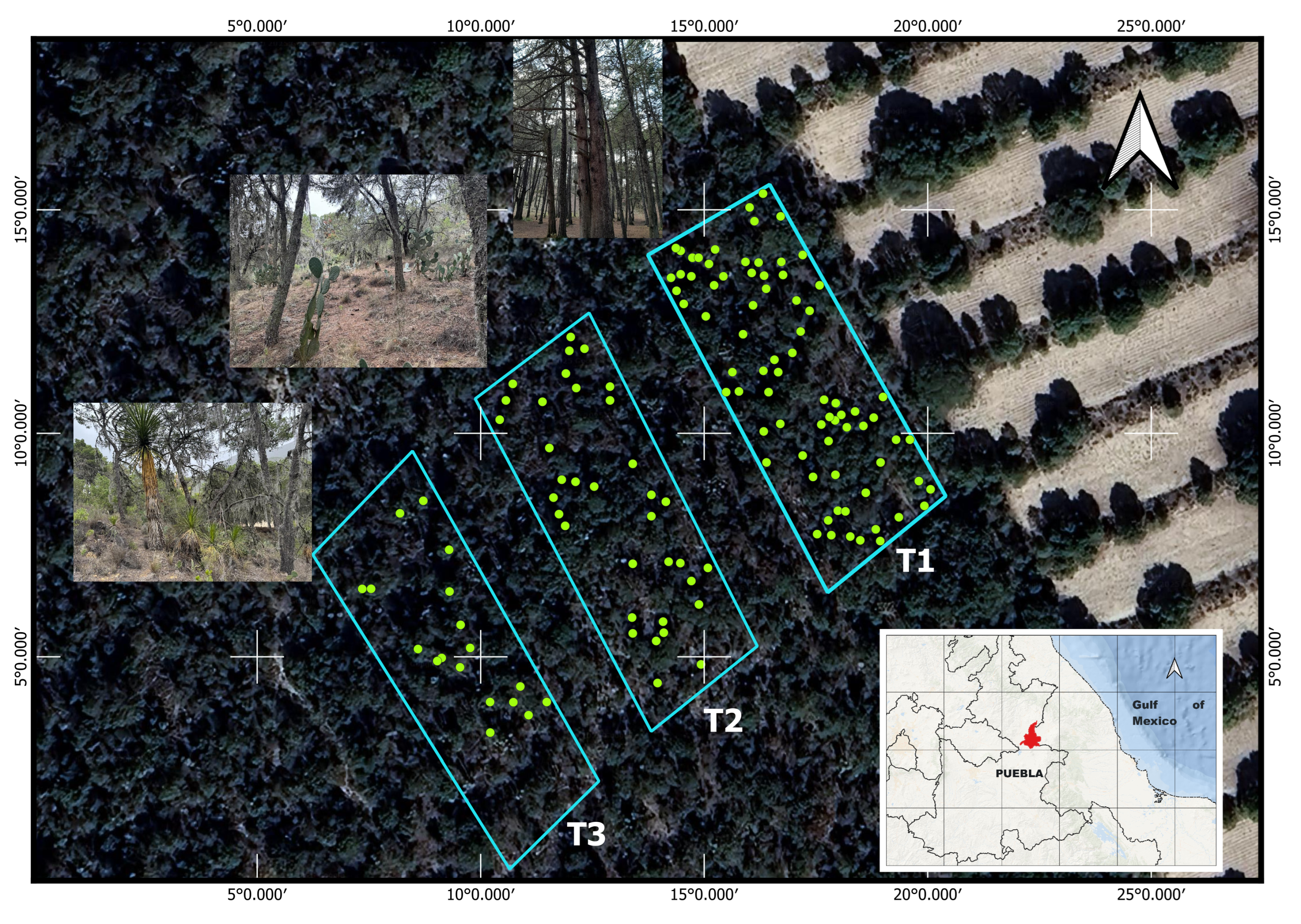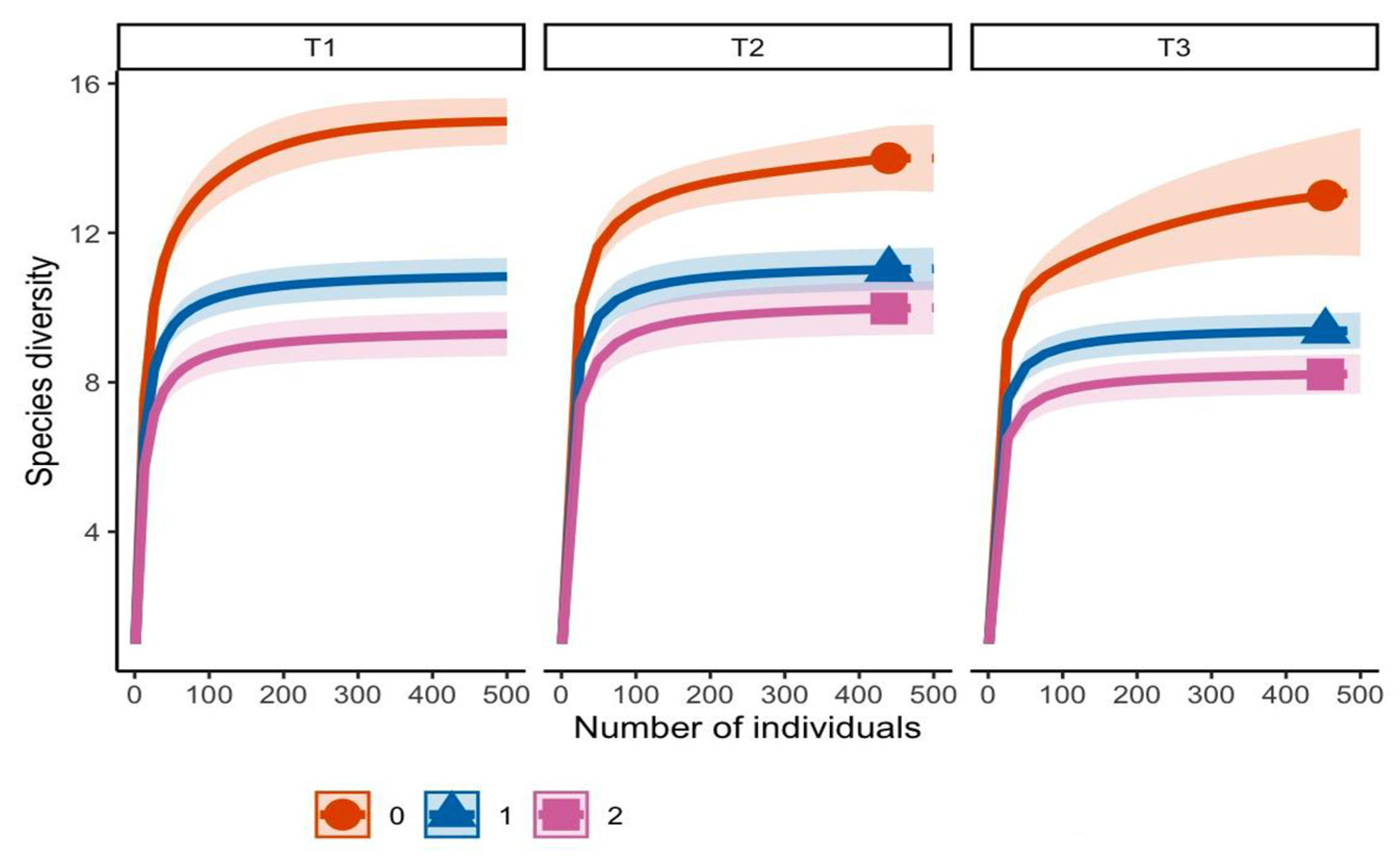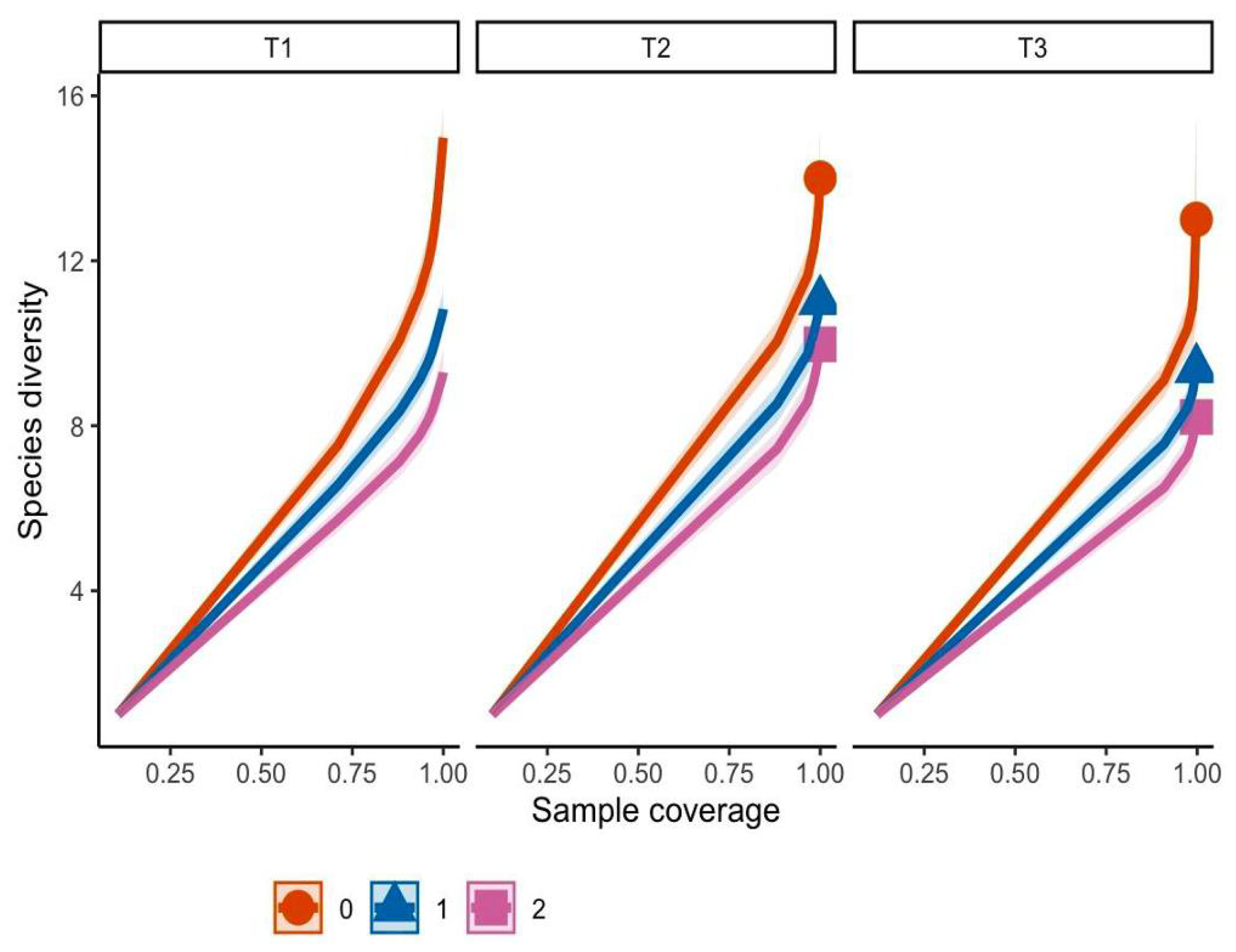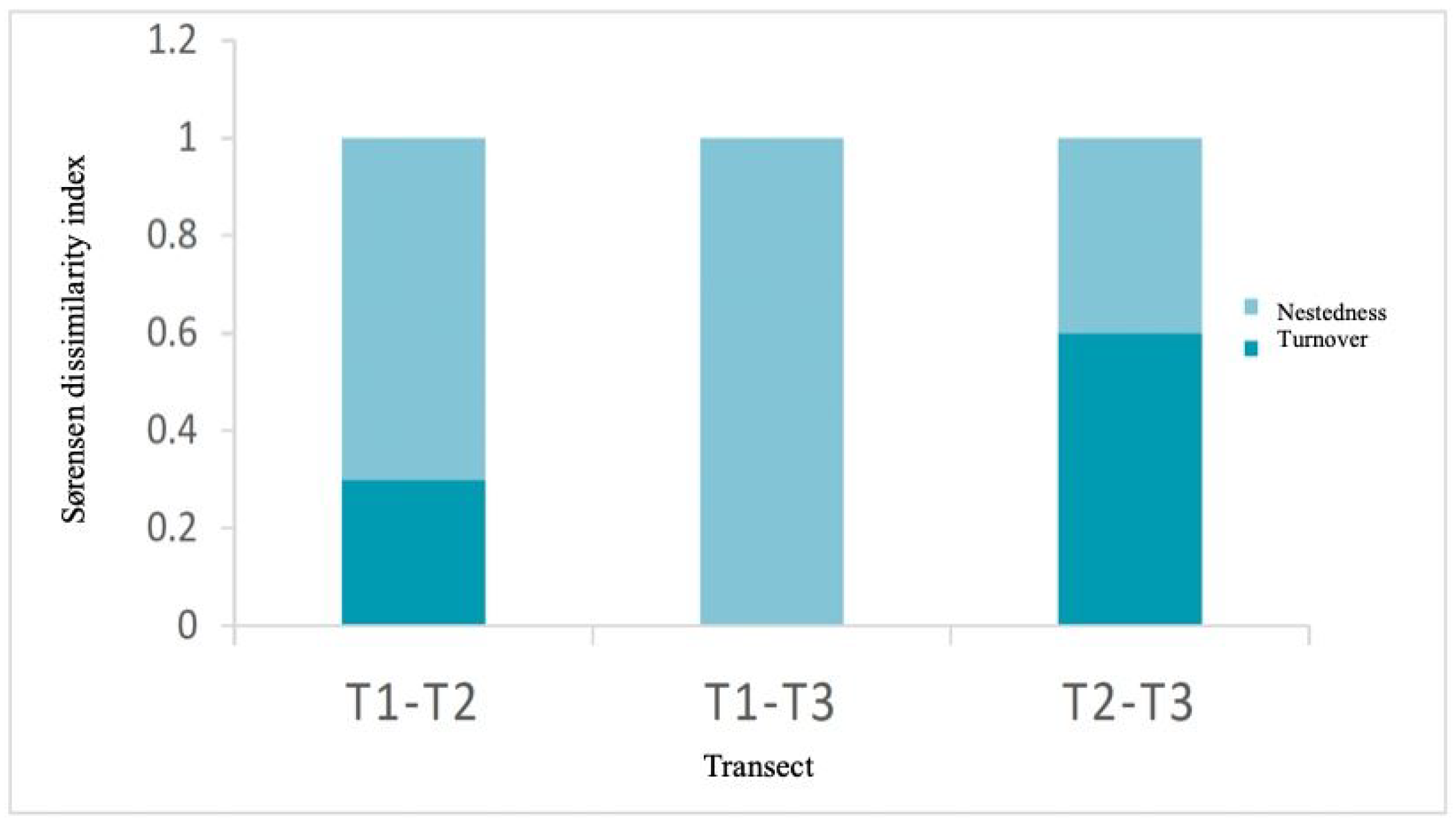Ectomycorrhizal Fungi Associated with Pinus cembroides subsp. orizabensis, an Endemic Pine in the Arid Zones of the Oriental Basin, Puebla, Mexico
Abstract
1. Introduction
2. Materials and Methods
2.1. Study Area
2.2. Sampling Design
2.3. Vegetation Characterization of the Transects
2.4. Sample Processing and Taxonomic/Molecular Root Tip Identification
2.5. Statistical and Diversity Analyses
3. Results
3.1. Morphotype Richness per Transect
3.2. Sampling Completeness Analysis
3.3. Beta Diversity Analysis
3.4. Characterization of EMF Morphotypes
3.5. Genetic Identification of EMF Morphotypes
4. Discussion
5. Conclusions
Author Contributions
Funding
Institutional Review Board Statement
Informed Consent Statement
Data Availability Statement
Acknowledgments
Conflicts of Interest
Abbreviations
| EMF | Ectomycorrhizal fungi |
| DNA | Deoxyribonucleic Acid |
References
- Dyshko, V.; Hilszczańska, D.; Davydenko, K.; Matić, S.; Moser, W.K.; Borowik, P.; Oszako, T. An Overview of Mycorrhiza in Pines: Research, Species, and Applications. Plants 2024, 13, 506. [Google Scholar] [CrossRef]
- Carrillo-Saucedo, S.M.; Puente-Rivera, J.; Montes-Recinas, S.; Cruz-Ortega, R. Las micorrizas como una herramienta para la restauración ecológica. Acta Bot. Mex. 2022, 129, e1932. [Google Scholar] [CrossRef]
- Alva-Rodríguez, S.; López-Upton, J.; Vargas-Hernández, J.J.; Ruiz-Posadas, L.D.M. Biomass and growth of Pinus cembroides Zucc. and Pinus orizabensis D.K. Bailey & Hawksworth in response to water deficit. Rev. Chapingo Ser. Cienc. For. Ambient. 2020, 26, 71–83. [Google Scholar] [CrossRef]
- Quiñónez-Martínez, M.; Gómez-Flores, L.d.J.; Garza-Ocañas, F.; Valero-Galván, J.; Nájera-Medellín, J.A. Crecimiento de plantas de Pinus arizonica Engelm. inoculadas con Pisolithus tinctorius y Astraeus hygrometricus en invernadero. Rev. Chapingo Ser. Cienc. For. Ambient. 2023, 29, 99–118. [Google Scholar] [CrossRef]
- Pal, S.C.; Chatterjee, U.; Chakrabortty, R.; Roy, P.; Chowdhuri, I.; Saha, A.; Islam, A.R.M.T.; Alam, E.; Islam, K. Anthropogenic Drivers Induced Desertification under Changing Climate: Issues, Policy Interventions, and the Way Forward. Prog. Disaster Sci. 2023, 20, 100303. [Google Scholar] [CrossRef]
- Yin, D.; Song, R.; Qi, J.; Deng, X. Ectomycorrhizal Fungus Enhances Drought Tolerance of Pinus sylvestris var. mongolica Seedlings and Improves Soil Condition. J. For. Res. 2018, 29, 1775–1788. [Google Scholar] [CrossRef]
- Gehring, C.A.; Theimer, T.C.; Whitham, T.G.; Keim, P. Ectomycorrhizal Fungal Community Structure of Pinyon Pines Growing in Two Environmental Extremes. Ecology 1998, 79, 1562–1572. [Google Scholar] [CrossRef]
- Hachani, C.; Lamhamedi, M.S.; Cameselle, C.; Gouveia, S.; Zine El Abidine, A.; Khasa, D.P.; Béjaoui, Z. Effects of Ectomycorrhizal Fungi and Heavy Metals (Pb, Zn, and Cd) on Growth and Mineral Nutrition of Pinus halepensis Seedlings in North Africa. Microorganisms 2020, 8, 2033. [Google Scholar] [CrossRef]
- Zambonelli, A.; Donnini, D.; Rana, G.L.; Fascetti, S.; Benucci, G.M.N.; Iotti, M.; Morte, A.; Khabar, L.; Bawadekji, A.; Piattoni, F.; et al. Hypogeous Fungi in Mediterranean Maquis, Arid and Semi-Arid Forests. Plant Biosyst. 2014, 148, 392–401. [Google Scholar] [CrossRef]
- Perry, J.P., Jr. The Pines of Mexico and Central America; Timber Press: Portland, OR, USA, 1991; p. 231. [Google Scholar]
- Flores, A.; Buendía Rodríguez, E.; Pineda Ojeda, T.; Flores Ayala, E.; Méndez-González, J. Genetic Conservation and Use of Genetic Resources of 18 Mexican Pine Species. Diversity 2023, 15, 735. [Google Scholar] [CrossRef]
- Granados Victorino, R.L.; Granados Sánchez, D.; Sánchez-González, A. Caracterización y ordenación de los bosques de pino piñonero (Pinus cembroides subsp. orizabensis) de la Cuenca Oriental (Puebla, Tlaxcala y Veracruz). Madera Bosques 2015, 21, 23–43. [Google Scholar] [CrossRef][Green Version]
- Ramírez-García, E.O.; Márquez-Ramírez, J.; Alba-Landa, J.; Mendizábal-Hernández, L.D.C.; Cruz-Jiménez, H.; Díaz Rodríguez, T.E. Crecimiento de una plantación de Pinus cembroides subsp. orizabensis D.K. Bailey en Cerro de León, Veracruz, México. For. Verac. 2022, 24, 27–38. [Google Scholar] [CrossRef]
- Manzanilla Quiñones, U.; Delgado Valerio, P.; Hernández Ramos, J.; Molina Sánchez, A.; García Magaña, J.J.; Rocha Granados, M.D. Similaridad del nicho ecológico de Pinus montezumae y P. pseudostrobus (Pinaceae) en México: Implicaciones para la selección de áreas productoras de semillas y de conservación. Acta Bot. Mex. 2019, 126, e1398. [Google Scholar] [CrossRef]
- Martínez-Sánchez, J.N.; Cuéllar-Rodríguez, L.G.; Yerena Yamallel, J.I.; Cavazos, M.T.; Gárate-Escamilla, H.A. Comparison of climatic databases in modeling the potential distribution of Pinus cembroides Zucc. Rev. Mex. Cienc. For. 2023, 14, 135–158. [Google Scholar] [CrossRef]
- Johnson, P.T.J.; Preston, D.L.; Hoverman, J.T.; Richgels, K.L.D. Biodiversity decreases disease through predictable changes in host community competence. Nature 2013, 494, 230–233. [Google Scholar] [CrossRef]
- de la Fuente Solís, A.M.; Alanís Rodríguez, E.; Yáñez Díaz, M.I.; Cantú Silva, I.; Himmelsbach, W.; Martín del Campo Delgado, M.Å. Supervivencia y crecimiento de una reforestación de Pinus cembroides Zucc. en el noreste de México. Rev. Mex. De Cienc. For. 2024, 15, 86. [Google Scholar] [CrossRef]
- INEGI. Agricultural Census Map 2020: Soil Type. Instituto Nacional de Estadística y Geografía, 2025. Available online: https://www.inegi.org.mx/ (accessed on 21 November 2024).
- Baeza-Guzmán, Y.; Medel-Ortiz, R.; Garibay-Orijel, R. Morphological and genetic characterization of ectomycorrhizal fungi associated with Pinus hartwegii forests in Cofre de Perote National Park, Veracruz. Rev. Mex. Biodivers. 2017, 88, 41–48. [Google Scholar] [CrossRef]
- Agerer, R.; Rambold, G. DEEMY—An Information System for Characterization and Determination of Ectomycorrhizae. 2004–2025. Available online: http://www.deemy.de (accessed on 10 August 2024).
- Tedersoo, L.; Anslan, S.; Bahram, M.; Põlme, S.; Riit, T.; Liiv, I.; Kõljalg, U.; Kisand, V.; Nilsson, R.H.; Hildebrand, F.; et al. Shotgun metagenomes and multiple primer pair-barcode combinations of amplicons reveal biases in metabarcoding analyses of fungi. MycoKeys 2015, 10, 1–43. [Google Scholar] [CrossRef]
- Chao, A.; Jost, L. Coverage-based rarefaction and extrapolation: Standardizing samples by completeness rather than size. Ecology 2012, 93, 2533–2547. [Google Scholar] [CrossRef] [PubMed]
- Jost, L. Entropy and diversity. Oikos 2006, 113, 363–375. [Google Scholar] [CrossRef]
- Hsieh, T.C.; Ma, K.H.; Chao, A. iNEXT: An R package for rarefaction and extrapolation of species diversity (Hill numbers). Methods Ecol. Evol. 2016, 7, 1451–1456. [Google Scholar] [CrossRef]
- Hernández Moreno, M.M.; Islas Gutiérrez, J.; Guerra de la Cruz, V. Marketing margins of pine nuts (Pinus cembroides subsp. orizabensis) in Tlaxcala, Mexico. Rev. Mex. Cienc. Agríc. 2011, 2, 265–279. Available online: http://www.scielo.org.mx/scielo.php?script=sci_arttext&pid=S2007-09342011000200007&lng=es&tlng=es (accessed on 4 August 2025).
- Netherway, T.; Bahram, M. Melanized root-associated fungi: Key players in plant–soil systems. Trends Microbiol. 2024, 32, 1190–1199. [Google Scholar] [CrossRef]
- Reverchon, F.; del Pilar Ortega-Larrocea, M.; Bonilla-Rosso, G.; Perez-Moreno, J. Structure and species composition of ectomycorrhizal fungal communities colonizing seedlings and adult trees of Pinus montezumae in Mexican neotropical forests. FEMS Microbiol. Ecol. 2012, 80, 479–487. [Google Scholar] [CrossRef]
- Baeza Guzmán, Y.; Dorantes López, J.; Medel Ortiz, R.; Trejo Aguilar, D. Morphotypes of ectomycorrhizas in a chronosequence of Pinus patula Schiede ex Schltdl. & Cham. stands in eastern Mexico. Rev. Mex. Cienc. For. 2021, 12, 141–164. [Google Scholar] [CrossRef]
- Rodríguez-Gómez-Tagle, G.; Vargas-Hernández, J.; López-Upton, J.; Pérez-Moreno, J. Diversity of ectomycorrhizal fungal morphotypes and host adaptation in contrasting populations of Pinus greggii var. australis (Pinaceae). Acta Bot. Mex. 2024, 131, e2151. [Google Scholar] [CrossRef]
- Sevanto, S.; Gehring, C.A.; Ryan, M.G.; Patterson, A.; Losko, A.S.; Vogel, S.C.; Kuske, C.R. Benefits of symbiotic ectomycorrhizal fungi to plant water relations depend on plant genotype in pinyon pine. Sci. Rep. 2023, 13, 14424. [Google Scholar] [CrossRef]
- Flores-Rentería, L.; Lau, M.K.; Lamit, L.J.; Gehring, C.A. An elusive ectomycorrhizal fungus reveals itself: A new species of Geopora (Pyronemataceae) associated with Pinus edulis. Mycologia 2014, 106, 1011–1021. [Google Scholar] [CrossRef] [PubMed][Green Version]
- Almaraz Llamas, A.; Pérez-Moreno, J.; Torres-Aquino, M.; Carcaño-Montiel, M.G.; Hernández Ríos, I. Cenococcum geophilum and its association with Pinus maximartinezii, a native and endangered tree species of Mexico. Sci. Fungorum 2020, 49, e1222. [Google Scholar] [CrossRef]
- Comisión Nacional del Agua (CONAGUA). Tepeyahualco Climatology Station 21244; Comisión Nacional del Agua: Mexico City, Mexico, 2025. Available online: https://smn.conagua.gob.mx/es/climatologia/informacion-climatologica/informacion-estadistica-climatologica (accessed on 20 April 2024).
- Xu, L.; He, J.; Meng, Y.; Zheng, Y.; Lu, B.; Zhang, J.; Zhou, Y. Enhancing drought resistance in Pinus tabuliformis seedlings through root symbiotic fungi inoculation. Front. Plant Sci. 2024, 15, 1446437. [Google Scholar] [CrossRef]
- Bruns, T.D.; Peay, K.G.; Boynton, P.J.; Grubisha, L.C.; Hynson, N.A.; Nguyen, N.H.; Rosenstock, N.P. Inoculum potential of Rhizopogon spores increases with time over the first 4 yr of a 99-yr spore burial experiment. New Phytol. 2009, 181, 463–470. [Google Scholar] [CrossRef] [PubMed]
- Fernandez, C.W.; Koide, R.T. The function of melanin in the ectomycorrhizal fungus Cenococcum geophilum under water stress. Fungal Ecol. 2013, 6, 479–486. [Google Scholar] [CrossRef]
- Wang, H.; Kohler, A.; Martin, F.M. Biology, genetics, and ecology of the cosmopolitan ectomycorrhizal ascomycete Cenococcum geophilum. Front. Microbiol. 2025, 16, 1502977. [Google Scholar] [CrossRef]





| Morphotype | Taxonomic Identification | e-Value | % Identity | Match in UNITE/Accession | e-Value | % Identity | Match in NCBI GenBank/Accession |
|---|---|---|---|---|---|---|---|
| M4 | Tomentella sp. 1 | 0.0 | 90% | Tomentella sp./MW027952 | 0.0 | 91% | Tomentella sp./MW027950 |
| M5 | Uncultured fungus | - | - | Uncultured fungus/– | - | - | Uncultured fungus/– |
| M6 | Rhizopogon aff. subpurpurascens | 0.0 | 90% | Rhizopogon subpurpurascens/MK841952 | 0.0 | 90% | Rhizopogon subpurpurascens/EU669318 |
| M7 | Uncultured fungus | - | - | Uncultured fungus/– | - | - | Uncultured fungus/– |
| M8 | Tricholoma sp. 1 | 0.0 | 86% | Tricholoma moseri/KC152252 | 0.0 | 88% | Tricholoma moseri/KC152252 |
| M10 | Geopora arenicola | 0.0 | 97% | Geopora arenicola/UDB017620 | 0.0 | 98% | Geopora arenicola/FM206456 |
| Morphotype (Taxon) | Branching Type | Color | Length (mm) | Diameter (mm) | Rhizomorphs | Emanating Hyphae | Exploration Type |
|---|---|---|---|---|---|---|---|
| M1 (Inocybe sp. 1) | Dichotomous, curved | Yellow | 3–4 | 1.5 | No | Rare | Short |
| M2 (Pinirhiza sp. 1) | Dichotomous, inflated, straight | Dark brown | 4–5 | 1–1.5 | No | Proximal area | – |
| M3 (Pinirhiza sp. 2) | Dichotomous, straight | Dark red | 5–7 | 2–3 | No | No | Contact |
| M4 (Tomentella sp. 1) | Dichotomous, cylindrical, straight | Dark brown | 4–5 | 1 | No | Distal area | Medium |
| M5 (Pinirhiza sp. 3) | Dichotomous, cylindrical, straight | Dark brown/black | 4–6 | 2 | Yes | Yes | Short to medium |
| M6 (Rhizopogon aff. subpurpurascens) | Dichotomous, cylindrical, curved | Light brown | 4–6 | 1.5–2 | Yes | Yes | – |
| M7 (Pinirhiza sp. 4) | Dichotomous, cylindrical, straight | Black | 4–7 | 1.5 | Yes | No | Contact |
| M8 (Tricholoma sp. 1) | Dichotomous, cylindrical, sinuous | Brown/golden | 3–5 | 1.5 | No | Rare | Short |
| M9 (Cenococcum sp. 1) | Dichotomous, inflated, straight | Black | 3–5 | 2 | Yes | Yes | Short |
| M10 (Geopora arenicola) | Dichotomous, inflated, curved | Brown/red | 4 | 2 | No | No | Medium |
| M11 (Bankera sp. 1) | Dichotomous, cylindrical, sinuous | Black | 5–7 | 1.5 | Few | No | Medium |
| M12 (Russula sp. 1) | Unbranched tips, inflated or straight | Brown | 5–7 | 3 | No | Proximal area | Contact |
| M13 (Amphinema sp. 1) | Irregular, cylindrical, straight | Dark brown | 4 | 1.5 | Few to none | Yes | Medium |
| M14 (Tylospora sp. 1) | Dichotomous, inflated, straight | Light brown to whitish | 3–4 | 2–3 | No | No | Short |
| M15 (Russulaceae) | Dichotomous, turgid, straight | Light brown | 4–5 | 1 | No | No | Contact |
| M16 (Paxillus sp. 1) | Dichotomous, cylindrical, straight | Whitish | 4–6 | 2 | No | No | Long |
Disclaimer/Publisher’s Note: The statements, opinions and data contained in all publications are solely those of the individual author(s) and contributor(s) and not of MDPI and/or the editor(s). MDPI and/or the editor(s) disclaim responsibility for any injury to people or property resulting from any ideas, methods, instructions or products referred to in the content. |
© 2025 by the authors. Licensee MDPI, Basel, Switzerland. This article is an open access article distributed under the terms and conditions of the Creative Commons Attribution (CC BY) license (https://creativecommons.org/licenses/by/4.0/).
Share and Cite
Baeza-Guzmán, Y.; Vásquez-Jiménez, M.S.; Morgado-Viveros, E.; Sánchez-Landero, L.A.; Trejo-Aguilar, D. Ectomycorrhizal Fungi Associated with Pinus cembroides subsp. orizabensis, an Endemic Pine in the Arid Zones of the Oriental Basin, Puebla, Mexico. J. Fungi 2025, 11, 677. https://doi.org/10.3390/jof11090677
Baeza-Guzmán Y, Vásquez-Jiménez MS, Morgado-Viveros E, Sánchez-Landero LA, Trejo-Aguilar D. Ectomycorrhizal Fungi Associated with Pinus cembroides subsp. orizabensis, an Endemic Pine in the Arid Zones of the Oriental Basin, Puebla, Mexico. Journal of Fungi. 2025; 11(9):677. https://doi.org/10.3390/jof11090677
Chicago/Turabian StyleBaeza-Guzmán, Yajaira, Marian Silvana Vásquez-Jiménez, Elvira Morgado-Viveros, Luz Amelia Sánchez-Landero, and Dora Trejo-Aguilar. 2025. "Ectomycorrhizal Fungi Associated with Pinus cembroides subsp. orizabensis, an Endemic Pine in the Arid Zones of the Oriental Basin, Puebla, Mexico" Journal of Fungi 11, no. 9: 677. https://doi.org/10.3390/jof11090677
APA StyleBaeza-Guzmán, Y., Vásquez-Jiménez, M. S., Morgado-Viveros, E., Sánchez-Landero, L. A., & Trejo-Aguilar, D. (2025). Ectomycorrhizal Fungi Associated with Pinus cembroides subsp. orizabensis, an Endemic Pine in the Arid Zones of the Oriental Basin, Puebla, Mexico. Journal of Fungi, 11(9), 677. https://doi.org/10.3390/jof11090677






